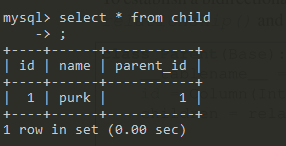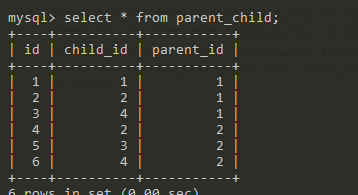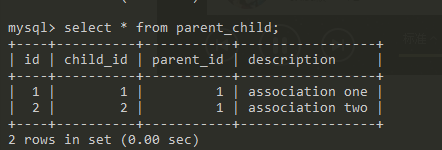sqlalchemy - day2
Relationship Configuration
一、one to many
直接上代码
from sqlalchemy import create_engine
engine = create_engine("mysql+pymysql://root:max123@127.0.0.1/test?charset=utf8", echo=False)
from sqlalchemy import *
from sqlalchemy.ext.declarative import declarative_base
from datetime import datetime, date
Base = declarative_base()
class Parent(Base):
__tablename__ = 'perent'
id = Column(Integer(), primary_key=True)
name = Column(String(50))
children = relationship('Child')
class Child(Base):
__tablename__ = 'child'
id = Column(Integer(), primary_key=True)
name = Column(String(50))
parent_id = Column(Integer(), ForeignKey('parent.id'))
现在Parent类就定义了one to many 的relationship, Child类没有定义任何relationship. backref一般用于单边的relationship,下图是官方文档的说明。

child_one = Child(name='purk')
parent = Parent(name='Wu', children=[child_one])
db.add(parent)
db.commit()
结果如下,在add parent时,关联的child 也 add 到数据库了。

现在分开操作,先add child,在add parent
child_one = Child(name='purk')
db.add(child_one)
db.commit()
结果如下,parent_id是null值

在执行如下代码
parent = Parent(name='Wu', children=[child_one])
db.add(parent)
db.commit()
结果如下,打开echo,可以看到SQL是先insert parent,然后update child.

二、many to one
直接上代码,现在Child对Parent就是many to one的关系
class Parent(Base):
__tablename__ = 'parent' id = Column(Integer(), primary_key=True)
name = Column(String(50))
children = relationship('Child', back_populates='parent') class Child(Base):
__tablename__ = 'child' id = Column(Integer(), primary_key=True)
name = Column(String(50))
parent_id = Column(Integer(), ForeignKey('parent.id'), nullable=True)
parent = relationship('Parent', back_populates='children')
通过relationship处理的类,可以直接用属性的方式访问到关联的父级或子级
from sqlalchemy.orm import sessionmaker Session = sessionmaker(bind=engine) db = Session() child_one = Child(name='purk')
parent = Parent(name='Wu', children=[child_one])
db.add(parent)
db.commit() child = db.query(Child).get(1)
print(child.parent.name)
结果如下

三、one to one
只需给relationship的uselist赋值为False, parent 对child就成了one to one的关系,只要保证many 的那一方加上uselist=False就可以了。
class Parent(Base):
__tablename__ = 'parent' id = Column(Integer(), primary_key=True)
name = Column(String(50))
child = relationship('Child', back_populates='parent', uselist=False) class Child(Base):
__tablename__ = 'child' id = Column(Integer(), primary_key=True)
name = Column(String(50))
parent_id = Column(Integer(), ForeignKey('parent.id'), nullable=True)
parent = relationship('Parent', back_populates='child')
之前的方式把child继续当成一个list就会报错了

不当成list,

四、many to many
方式一: 可以看出many to many 会有一个中间表,通过secondary指定,这个中间表是不需要维护的,做增删改时自动维护了,但是此中间表就没有有价值的字段,如果中间表需要增加一些除了外键的字段,就是下面的方 式二
from sqlalchemy import create_engine
engine = create_engine("mysql+pymysql://root:max123@127.0.0.1/test?charset=utf8", echo=False)
from sqlalchemy import *
from sqlalchemy.orm import relationship
from sqlalchemy.ext.declarative import declarative_base
from datetime import datetime, date
Base = declarative_base()
class ParentChild(Base):
__tablename__ = 'parent_child'
id = Column(Integer(), primary_key=True)
child_id = Column(Integer(), ForeignKey('child.id'), nullable=False)
parent_id = Column(Integer(), ForeignKey('parent.id'), nullable=False)
class Parent(Base):
__tablename__ = 'parent'
id = Column(Integer(), primary_key=True)
name = Column(String(50))
children = relationship('Child', back_populates='parents', secondary=ParentChild.__table__)
class Child(Base):
__tablename__ = 'child'
id = Column(Integer(), primary_key=True)
name = Column(String(50))
parents = relationship('Parent', back_populates='children', secondary=ParentChild.__table__)
Base.metadata.drop_all(engine)
Base.metadata.create_all(engine)
from sqlalchemy.orm import sessionmaker
Session = sessionmaker(bind=engine)
db = Session()
child_one = Child(name='purk1')
child_two = Child(name='purk2')
child_three = Child(name='purk3')
child_four = Child(name='purk4')
parent_one = Parent(name='Wu1')
parent_two = Parent(name='Wu2')
parent_one.children.extend([child_one, child_two])
parent_two.children.extend([child_two, child_three])
child_four.parents.extend([parent_one, parent_two])
db.add_all([parent_one, parent_two, child_four])
db.commit()
结果如下

加上如下的delete操作代码
parent_one.children.remove(child_one)
db.merge(parent_one)
db.commit()
db.delete(child_three)
db.commit()
结果如下

方式二:many to one 然后 one to many,这样就可以把中间表利用起来了
from sqlalchemy import create_engine
engine = create_engine("mysql+pymysql://root:max123@127.0.0.1/test?charset=utf8", echo=False)
from sqlalchemy import *
from sqlalchemy.orm import relationship
from sqlalchemy.ext.declarative import declarative_base
from datetime import datetime, date
Base = declarative_base()
class Parent(Base):
__tablename__ = 'parent'
id = Column(Integer(), primary_key=True)
name = Column(String(50))
children = relationship('ParentChild', back_populates='parent')
class Child(Base):
__tablename__ = 'child'
id = Column(Integer(), primary_key=True)
name = Column(String(50))
parents = relationship('ParentChild', back_populates='child')
class ParentChild(Base):
__tablename__ = 'parent_child'
id = Column(Integer(), primary_key=True)
child_id = Column(Integer(), ForeignKey('child.id'), nullable=False)
parent_id = Column(Integer(), ForeignKey('parent.id'), nullable=False)
description = Column(String(100))
parent = relationship('Parent',back_populates='children')
child = relationship('Child',back_populates='parents')
Base.metadata.drop_all(engine)
Base.metadata.create_all(engine)
from sqlalchemy.orm import sessionmaker
Session = sessionmaker(bind=engine)
db = Session()
child_one = Child(name='purk1')
child_two = Child(name='purk2')
child_three = Child(name='purk3')
child_four = Child(name='purk4')
parent_one = Parent(name='Wu1')
parent_two = Parent(name='Wu2')
parent_child_one = ParentChild(description='association one')
parent_child_two = ParentChild(description='association two')
parent_child_one.child = child_one
parent_child_two.child = child_two
parent_one.children.extend([parent_child_one, parent_child_two])
db.add_all([parent_one, parent_two, child_four])
db.commit()
结果如下

加入如下代码
parent_one.children.pop(0)
# parent_one.children[1].append(child_three)
db.merge(parent_one)
db.commit()
报错了如下,当然前面定义中间表的时候定义了nullable= False, 可是SQL要强行把起更新为Null,肯定报错咯。虽然去掉nullable=False的限制,但是这可能也不是我想要的,我想要的是直接删掉这条记录的。


想到就去做,给relationship加上cascade='all,delete-orphan', cascade官方解释如下
2.5.3 Cascades
Mappers support the concept of configurable cascade behavior on relationship() constructs. This refers to how
operations performed on a “parent” object relative to a particular Session should be propagated to items referred to
by that relationship (e.g. “child” objects), and is affected by the relationship.cascade option.
The default behavior of cascade is limited to cascades of the so-called save-update and merge settings. The typical
“alternative” setting for cascade is to add thedeleteand delete-orphanoptions; these settings are appropriate for related
objects which only exist as long as they are attached to their parent, and are otherwise deleted.
Cascade behavior is configured using the by changing the cascade option on relationship():
class Order(Base):
__tablename__ = 'order'
items = relationship("Item", cascade="all, delete-orphan")
customer = relationship("User", cascade="save-update")
To set cascades on a backref, the same flag can be used with the backref() function, which ultimately feeds its
arguments back into relationship():
class Item(Base):
__tablename__ = 'item'
order = relationship("Order",
backref=backref("items", cascade="all, delete-orphan")
)
加上cascade以后,在删除children时,就会把parent_child表里面的记录删掉了。
class Parent(Base):
__tablename__ = 'parent' id = Column(Integer(), primary_key=True)
name = Column(String(50))
children = relationship('ParentChild', back_populates='parent',cascade='all,delete-orphan')
结果如下

backref与relationship同功能的属性有 uselist和cascade。
lazy ='select' :
1) select: lazy加载模式,只在真正调用这个属性时才会去访问数据库
class Parent(Base):
__tablename__ = 'parent' id = Column(Integer(), primary_key=True)
name = Column(String(50))
children = relationship('ParentChild', back_populates='parent', cascade='all,delete-orphan', lazy='select') parent = db.query(Parent).get(1)
db.close()
结果是没有去请求parent_child的数据

parent = db.query(Parent).get(1)
parent.children
db.close()
结果如下,对比这两个结果,可以看出,parent.children在执行的时候才去请求的数据。

2) immediate: 直接加载,随父级以子查询的方式一同访问数据库。
parent = db.query(Parent).get(1)
# parent.children
db.close()
结果是,在parent加载的时候就已经加载数据了。

3) joined: 直接加载,随父级以join的方式一同访问数据库,具体是 inner join还是outer join(left join)就看relationship的innerjoin属性时True还是False了。
class Parent(Base):
__tablename__ = 'parent' id = Column(Integer(), primary_key=True)
name = Column(String(50))
children = relationship('ParentChild', back_populates='parent', cascade='all,delete-orphan', lazy='joined') parent = db.query(Parent).get(1)
# parent.children
db.close()
结果可以看出parent加载数据的时候就join出了children的数据

class Parent(Base):
__tablename__ = 'parent' id = Column(Integer(), primary_key=True)
name = Column(String(50))
children = relationship('ParentChild', back_populates='parent', cascade='all,delete-orphan', lazy='joined', innerjoin=True) parent = db.query(Parent).get(1)
# parent.children
db.close()
innerjoin参数的作用

4) subquery: 结果集连接查询的方式跟随parent一起加载出数据
children = relationship('ParentChild', back_populates='parent', cascade='all,delete-orphan', lazy='subquery')
parent = db.query(Parent).get(1)
# parent.children
db.close()
5) noload:no loading should occur at any time. This is to support “write-only” attributes,
or attributes which are populated in some manner specific to the application. 官方文档解释,感觉没有什么实际意思。
6) dynamic: 返回query对象,可一直使用filter等条件过滤。
children = relationship('ParentChild', back_populates='parent', cascade='all,delete-orphan', lazy='dynamic')
parent = db.query(Parent).get(1)
parent.children.all()
db.close()
结果如下,看代码就明白其意义了。

sqlalchemy - day2的更多相关文章
- Python之路:Python操作 RabbitMQ、Redis、Memcache、SQLAlchemy
Memcached Memcached 是一个高性能的分布式内存对象缓存系统,用于动态Web应用以减轻数据库负载.它通过在内存中缓存数据和对象来减少读取数据库的次数,从而提高动态.数据库驱动网站的速度 ...
- 【从零开始学BPM,Day2】默认表单开发
[课程主题]主题:5天,一起从零开始学习BPM[课程形式]1.为期5天的短任务学习2.每天观看一个视频,视频学习时间自由安排. [第二天课程] Step 1 软件下载:H3 BPM10.0全开放免费下 ...
- sqlalchemy学习
sqlalchemy官网API参考 原文作为一个Pythoner,不会SQLAlchemy都不好意思跟同行打招呼! #作者:笑虎 #链接:https://zhuanlan.zhihu.com/p/23 ...
- tornado+sqlalchemy+celery,数据库连接消耗在哪里
随着公司业务的发展,网站的日活数也逐渐增多,以前只需要考虑将所需要的功能实现就行了,当日活越来越大的时候,就需要考虑对服务器的资源使用消耗情况有一个清楚的认知. 最近老是发现数据库的连接数如果 ...
- 冰冻三尺非一日之寒-mysql(orm/sqlalchemy)
第十二章 mysql ORM介绍 2.sqlalchemy基本使用 ORM介绍: orm英文全称object relational mapping,就是对象映射关系程序,简单来说我们类似pyt ...
- Python 【第六章】:Python操作 RabbitMQ、Redis、Memcache、SQLAlchemy
Memcached Memcached 是一个高性能的分布式内存对象缓存系统,用于动态Web应用以减轻数据库负载.它通过在内存中缓存数据和对象来减少读取数据库的次数,从而提高动态.数据库驱动网站的速度 ...
- SQLAlchemy(一)
说明 SQLAlchemy只是一个翻译的过程,我们通过类来操作数据库,他会将我们的对应数据转换成SQL语句. 运用ORM创建表 #!/usr/bin/env python #! -*- coding: ...
- NOIp2016 Day1&Day2 解题报告
Day1 T1 toy 本题考查你会不会编程. //toy //by Cydiater //2016.11.19 #include <iostream> #include <cstd ...
- sqlalchemy(二)高级用法
sqlalchemy(二)高级用法 本文将介绍sqlalchemy的高级用法. 外键以及relationship 首先创建数据库,在这里一个user对应多个address,因此需要在address上增 ...
随机推荐
- IOS开发-跨域访问DWR方法
用Phonegap做手机客户端,服务器用spring+DWR,需要在手机端访问服务器的方法,需要做以下配置,可以参见http://www.iteye.com/topic/337460: 服务器DWR配 ...
- 文件的输出与载入之java操作
一.前言 学习java没多久,关键是没怎么系统学过.都是看别人的代码来学习的.今天就把一直以来让我头痛的java IO 的一些基本操作来记录下来,加深记忆. 二.java导入文件到内存中 首先放一个 ...
- python写的battle ship小游戏 - 1.0
最近学python,这是今天写的一个小游戏. from random import randint class Board(object): board = [] def __init__(self, ...
- C# Exception 对象的属性
关于 C# 中 Exception 对象的属性,在程序出现异常时,需要记录异常的信息,并把信息保存起来或输出,以方便准确定位异常的根源,以下是 Exception 对象的属性 名称 ...
- noip2009 潜伏者
P1071 潜伏者 827通过 2.2K提交 题目提供者洛谷OnlineJudge 标签字符串模拟2009NOIp提高组 难度普及/提高- 提交该题 讨论 题解 记录 题目描述 R 国和 S 国正 ...
- Duilib学习笔记《04》— 窗体显示
在前面已经了解了duilib控件以及界面布局相关内容,接下来就要考虑该如何将xml中描述的布局通过界面展现出来.实际上在 Duilib学习笔记<01> 中我们已经简单提到过基本的流程及元素 ...
- Android IOS WebRTC 音视频开发总结(四八)-- 从商业和技术的角度看视频行业的机会
本文主要从不同角度介绍视频行业的机会,文章来自博客园RTC.Blacker,支持原创,转载必须说明出处,欢迎关注个人微信公众号blacker ----------------------------- ...
- LLVM language 参考手册(译)(3)
可见性模式(Visibility Styles) 所有全局变量和函数具有以下的可见性模式之一: “default” - Default style 在那些使用ELF object file格式的平台( ...
- 搭建高性能计算环境(二)、远程登录Linux服务器
一般操作Linux系统都是通过远程登录使用的,本节介绍几种远程登录Linux.上传下载文件的工具. 1. Secure Shell SSH 简单方便.既能使用命令行登陆也能传文件,免费. 打开SSH ...
- LoadCursor 函数
从可执行文件中载入指定的光标资源,加载到指定的应用实例中 ? 1 2 3 4 5 HCURSOR WINAPI LoadCursor( _In_opt_ HINSTANCE hInstance, ...
